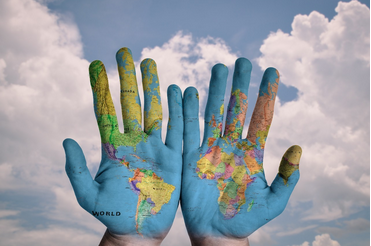
Last week, the world marked the 51st Earth Day. This year’s theme – “Restore Our Earth” – was apt. As the COVID-19 pandemic has reminded us, the effects of human activity on the planet do not respect borders. The Earth is a single living, self-regulating system, and it demands a single, shared system of accounting that balances at the global level. We need a one-Earth balance sheet.
In a 1946 telegram, Albert Einstein pleaded for funding to finance the “life-and-death struggle to harness the atom for the benefit of mankind and not for humanity’s destruction,” arguing that a “a new type of thinking is essential if mankind is to survive and move toward higher levels.” The same can be said about the environmental crisis humanity has created. Surviving it, and achieving a better, more sustainable future, requires “a new type of thinking.”
The old type of thinking produced a policy framework based on the nation-state. Policymakers consider the material impact of their actions on the local population, as measured by quantitative economic indicators like GDP. The United Nations System of National Accounts – devised in 1953, updated in 1993, and reaffirmed in 2008 – emphasizes the measurement of flows, such as income, expenditure, imports, and exports.
But even if there were enough data – such as on land valuation and intellectual property rights – national accounting systems would suffer from stock-flow inconsistencies. Under-measurement of many assets and liabilities, and of profits and losses, means that imbalances are often lumped into Errors and Omissions, making their impact difficult to gauge.
At the one-Earth system level, all flows and stocks would have to balance. This would make it far easier to measure the impact of each country’s activity on the whole.
There is a traditionally economic dimension to this imperative. After the 1997 Asian financial crisis, for example, it became clear that efforts by Japanese firms and banks to restore their balance sheets led to depression or financial contagion elsewhere. In today’s ultra-integrated global economy, there is no pretending that national balance sheets exist in isolation. And if one country’s balance sheet becomes too fragile, others will also be put at risk.
But there is also a social dimension to this challenge. Consider the growing global debt overhang. Every debt incurred has a corresponding asset, which is sustainable if it yields a social rate of return larger than the cost of the funds. Yet these social returns (or costs) are rarely measured – a significant blind spot for those devising policies to avoid debt distress. A better approach would account for both the debt and the associated asset, including the relevant costs and benefits. That requires a global perspective, shaped by economic, social, and ecological considerations.
More broadly, a one-Earth balance sheet would go a long way toward mapping global imbalances. Some, such as income and wealth imbalances, are already obvious. But others, such as pollution and choke points in global supply chains, have not yet been mapped adequately.
Innovative initiatives by companies like Visual Capitalist suggest the benefits of such maps. For example, by charting high-cost carbon-emitting consumption patterns more clearly, the world would be better equipped to address them through targeted innovation and investment.
This points to another major benefit of the one-Earth balance sheet: it may reveal areas where global or regional cooperation would deliver important, if indirect, benefits. For example, a system-wide perspective would probably show that the world has a strong economic and ecological interest in acting collectively to help Africa manage challenges relating to population, food, energy, health, and security.
Perhaps most fundamentally, the one-Earth balance sheet would highlight that individual countries’ right to act in their interests comes with obligations. If a country, say, expands intensive land use or builds polluting factories, its national account would highlight the GDP benefits, which might be deemed to outweigh the ecological costs. But the one-Earth account would show how externalities like deforestation and pollution damage human health, jobs, and the environment elsewhere, thereby changing the calculation significantly.
Japan’s recent decision gradually to release treated wastewater from the Fukushima Daiichi nuclear plant into the Pacific provides a clear example of this tension. Japanese authorities say opposition is unscientific. But critics insist the release would damage the environment and violate human rights in surrounding countries.
Whatever the best solution is, the issue clearly does not affect only Japan. The country must, therefore, account for not only the internal costs of finding an alternate solution, but also the external obligations its chosen solution implies. Even if the wastewater itself proves safe, the decision could fuel mistrust that may end up producing large shared losses.
The pandemic has highlighted how collective challenges need whole-of-government and whole-of-society solutions. It has also showed how a lack of complete, transparently shared data can lead to flawed and piecemeal approaches, as well as harmful misunderstandings.
We have enough economic and ecological data to prepare a first draft of a one-Earth balance sheet, thanks partly to Big Data and social media. These data can and should be compiled collectively, much like Wikipedia. Indeed, given the one-Earth balance sheet’s multidimensional and multi-disciplinary nature, it would be inappropriate for any one individual or group to take on the task. A global commission, convened under multilateral auspices, should spearhead this effort.
Creating a one-Earth framework will not be easy and will undoubtedly run into nationalist resistance in many countries. But, like the harnessing of the atom, this is a life-and-death struggle. And a one-Earth balance sheet represents the “new type of thinking” we need to “survive and move toward higher levels.”
Copyright: Project Syndicate, 2021.
www.project-syndicate.org